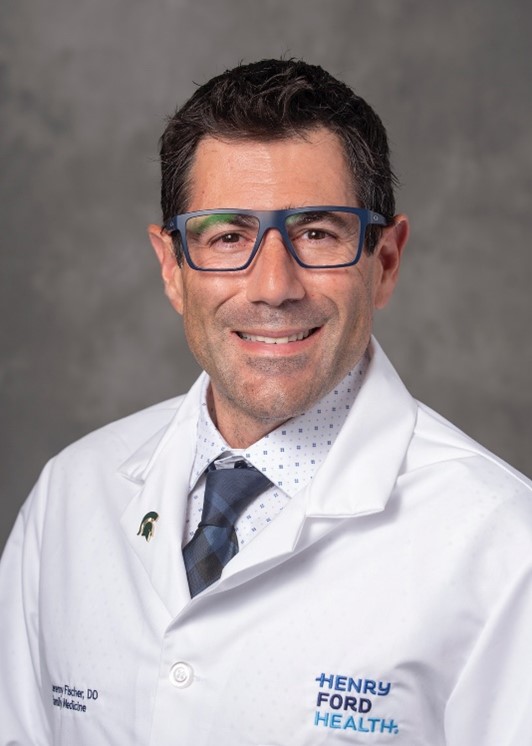
Jeremy Fischer, DO, FACOFP
Henry Ford Macomb Program Director of Family Medicine and site director for Michigan State University core curriculum clerkship
This blog is part two of a six-part series on the art of preceptorship. Learn more about becoming a preceptor.
I began my journey in medical education as a family medicine resident, where I first discovered my passion for precepting medical students. This interest deepened when I transitioned to urgent care, where I enjoyed teaching rotating students about procedures and patient care, helping them build their skills in a fast-paced environment. Eventually, as I took on the role of an attending physician in a resident clinic and later became the program director, my commitment to precepting flourished. I found great fulfillment in mentoring and shaping the next generation of physicians, emphasizing the importance of patient-centered care and fostering their growth as healthcare providers.
What aspect of being a preceptor do you find the most rewarding?
My passion for precepting medical students stems from witnessing their remarkable transformation as they transition from book learning and board study to applying their medical knowledge to real patients. There's something incredibly rewarding about seeing them grow, developing the skills and confidence needed to become full-fledged physicians. Watching them take care of people in the community, making a tangible impact on lives, is one of the most fulfilling aspects of my role as a preceptor. It’s a privilege to guide them on this journey and to see their dedication and compassion flourish as they prepare for their future in medicine.
What are some of the common challenges you face as a preceptor, and how do you address them?
Precepting medical students comes with its challenges, especially when I see them get overwhelmed by a complex clinical presentation. Often, they lack a complete clinical framework and struggle to organize their thoughts, which can lead to incomplete clinical presentations. On busy days, this can be tough to navigate. I’ve found that early students benefit from focusing on just one or two complaints, allowing them to leave the rest for me to address. Helping them review the chart and the specific complaint beforehand can provide much-needed guidance. I encourage them to think critically about the assessment and plan, which helps them begin to think like clinicians. I also emphasize that it’s okay to be wrong; that’s part of the learning process. I want them to understand that developing an assessment and plan, even if it’s not perfect, is crucial for their growth. Creating a supportive environment where they feel comfortable sharing their thoughts without fear of criticism is essential for fostering their confidence and development.
How do you handle situations where a student isn’t meeting your expectations or is struggling with clinical skills?
It’s crucial to start by providing clear, written guidelines at the beginning of the rotation. Sometimes, we assume that our expectations are understood, but learners often aren’t aware of what’s expected of them. I send them an email outlining everything, including arrival times, appropriate attire, lunch breaks, and when they can expect to finish for the day, so they can plan accordingly. I also include examples of notes and a reading list, emphasizing that they should dedicate at least 30 minutes each night to studying the cases we’ll encounter.
If expectations aren’t met, I make it a point to take the student aside privately to discuss the issue and understand their perspective. It’s important for them to grasp that these expectations are part of their evaluation. For students who struggle clinically, the approach is a bit different. Often, they have the drive but need guidance on applying their knowledge to patient care. I provide them with readings on common topics we see in practice and encourage them to focus on one specific topic each day. I ask them to gather a complete history related to that topic and develop a plan, which allows us to build on their understanding gradually. This tailored approach helps them gain confidence and improves their clinical skills over time.
What advice would you give to new preceptors who might feel overwhelmed by balancing patient care and teaching?
When things get busy and overwhelming during clinic, I approach precepting with a flexible mindset, recognizing that students learn in various ways and don’t necessarily need to see a high volume of patients to gain valuable experience. I allow them to see selected patients while I take on others, giving them time to formulate their plans. If the clinic is particularly hectic, I pull them into the room with me and ask them to observe something specific. Since I’m familiar with the patients, I can highlight targeted teaching points for them to focus on, whether it’s how I gather a patient’s history, counsel a hesitant patient, or explain the consent process for a procedure.
It’s also essential for students to learn proper documentation, so I ensure they have time to write their notes and review them later. This way, they can continue learning while I catch up on patient care. We implemented a change where students head home at 3 p.m. instead of staying until the end of clinic. This adjustment has worked wonders, allowing students time to read and reflect, while also giving preceptors the opportunity to manage inbox messages and patient care more efficiently, ensuring everyone can finish on time. This collaborative approach fosters a positive learning environment, even in the busiest of settings.





